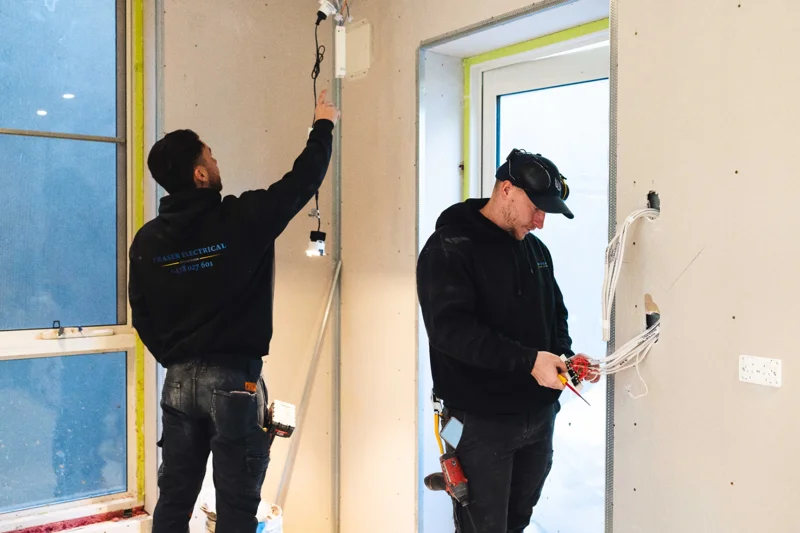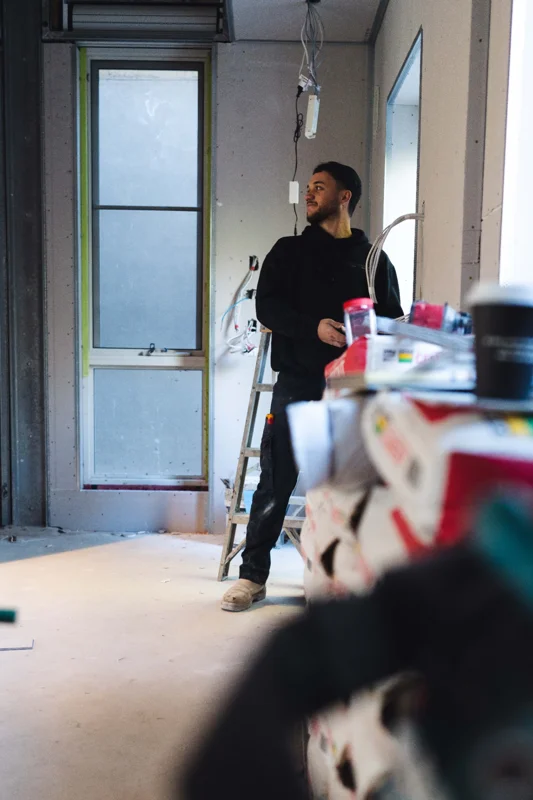Renovating an older home on the Central Coast? Upgrading the wiring makes sense, but it’s also where things can go seriously wrong if you’re not careful. Experts at Fraser Electrical have seen firsthand how outdated systems, overloaded switchboards, and poor planning can turn a dream renovation into a safety hazard. This guide highlights the most common wiring pitfalls to avoid when modernising your home.
From replacing brittle cables to planning smart layouts and boosting energy efficiency, we’ll guide you through the key steps to make your electrical upgrade safe, functional, and future-ready without compromising your home’s character. Let's get started!

In the Central Coast region, many homes possess a unique charm that stems from their historical architecture and design. However, with this charm often comes the challenge of ageing electrical systems. Ignoring the age and condition of existing wiring in older homes can lead to safety hazards and inefficiencies. Tackling these problems early keeps your home safe and your power running smoothly.
One of the most prevalent issues in older homes is brittle insulation. Over time, the rubber or fabric insulation that surrounds electrical wires can deteriorate, becoming brittle and prone to cracking. This deterioration exposes the conductive wires underneath, increasing the risk of short circuits and electrical fires. Homeowners should be vigilant in checking the condition of their wiring insulation, especially in homes that are several decades old.
Another common issue is undersized circuits. Older homes weren’t built to handle the power demands we have today.
With modern appliances, home offices, and entertainment systems running at once, outdated wiring can quickly become overwhelmed. This often leads to tripped breakers or overheating. Upgrading to properly sized circuits ensures your home can safely handle current electrical loads.
If you're experiencing frequent electrical issues such as flickering lights, sparking outlets, or circuit breakers that trip often, it may be a sign that your wiring needs replacement rather than temporary fixes. These issues indicate that your electrical system is unable to handle the current load or that there is a deeper underlying problem with the wiring itself.
Discolouration or warmth around outlets is a sign of problematic wiring. It usually means there’s overheating or sparking, which are both serious safety risks that need urgent attention. If you notice any of these issues emanating from your outlets, you must contact a professional electrician in Central Coast to assess the situation.
A burning smell could mean something’s overheating, possibly from worn-out or damaged wiring. Act quickly to avoid serious fire hazards. Remember that ignoring such signs can lead to devastating electrical fires. If you detect any strange smell, turn off the power to the affected area and consult with an electrician immediately.
Lastly, consider the age of your home. If your property is more than 40 years old and still has its original wiring, it's likely time for a comprehensive evaluation and potential replacement. Even if there are no apparent issues, the age of the wiring alone can be a risk factor due to the natural degradation of materials over time.
Patching up small problems might feel like the cheaper fix, but it’s usually just a short-term band-aid.
Replacing outdated wiring gives you peace of mind. It brings your home up to current safety standards and ensures your system can handle the power you need today. It’s a smart long-term investment that boosts both safety and property value.
When renovating older homes, one of the most critical areas that requires careful attention is the electrical system. A common mistake often made during such updates is overloading outdated switchboards by connecting new appliances and electrical systems without considering the capacity and condition of the existing infrastructure. This section discusses the risks associated with this oversight and the importance of switchboard upgrades.
Older homes are typically equipped with switchboards designed to handle the electrical loads of their time. However, with the advent of modern technology, the demand for electricity has increased. High-powered devices like air conditioners and induction cooktops need stable, sufficient current, something outdated switchboards can’t reliably provide. Connecting these power-hungry devices to outdated switchboards can lead to several risks, including:
With all these risks, upgrading your switchboard isn’t just helpful; it’s essential for safety. Here’s why switchboard upgrades are often essential:
A key component of modern switchboards is the inclusion of safety switches and residual current devices (RCDs), which are vital for protecting both the home and its occupants.
When renovating older homes, one critical aspect that often gets overlooked is the strategic planning of power points and lighting placement. As living spaces have evolved, so have electrical needs. To ensure a successful renovation, consider modern living requirements, future-proofing strategies, and the integration of smart technologies.
In older homes, electrical systems were designed for a different era, often with fewer appliances and gadgets in mind. Today, reliance on technology has transformed how people use their living spaces. Kitchens are not just for cooking; they're also spaces for socialising and working. Living rooms are multimedia hubs, and home offices have become essential. That shift means your electrical setup probably needs a rethink.
Failing to account for these changes can lead to insufficient power points, causing homeowners to resort to unsightly and unsafe extension cords. During renovations, assess each room's specific functions and plan accordingly. For instance, a modern kitchen may require additional outlets for high-powered appliances, while a living room might benefit from strategically placed power points for entertainment systems.
One of the best ways to avoid the pitfalls of poor planning is to future-proof your home with ample outlets and well-thought-out lighting zones. Future-proofing means anticipating the current needs and potential changes in technology and lifestyle.
Consider the placement of outlets with furniture and appliances. For instance, having outlets at countertop height in kitchens or besides the bed in bedrooms can enhance convenience. Also, it's wise to install more power points than you think you need. This approach can accommodate future devices and reduce the need for disruptive upgrades later.
Split larger rooms into separate lighting zones so you can change the mood and function easily. For example, a living room might benefit from separate zones for reading, watching TV, and entertaining. Furthermore, using different types of lighting, such as ambient, task, and accent lighting, can enhance the functionality and aesthetic appeal of a room.
The integration of smart technologies is becoming increasingly popular in home renovations. Smart switches and dimmers offer a range of benefits, including energy efficiency, convenience, and enhanced control over lighting environments.
These can be controlled remotely via smartphones or voice-activated devices, providing you with flexibility and control over your lighting systems even when you are not at home. Smart switches can be programmed to follow specific schedules, helping to conserve energy by ensuring lights are only on when needed.
Installing dimmers allows for the adjustment of light intensity, creating the perfect atmosphere for any occasion. They also contribute to energy savings by reducing power consumption when full brightness is not necessary. Pairing dimmers with smart technology can further enhance their functionality, allowing for custom lighting scenes tailored to different activities or moods.

When undertaking wiring renovations in older homes, one of the oversights is failing to incorporate energy efficiency improvements. In today's environmentally conscious world, updating your home's electrical system provides an excellent opportunity to reduce energy consumption, lower utility bills, and enhance the overall comfort and functionality of your living spaces. Below, we explore some key areas where you can improve energy efficiency during your electrical updates.
Switching to LED lighting is one of the simplest yet most impactful changes you can make during a wiring renovation.
Think about how each room feels and how you use it, then pick lighting that fits the vibe and purpose. Consulting with a professional electrician can help you select the right products and ensure proper installation.
Integrating smart home technology during electrical rewiring can enhance your home's energy efficiency.
When planning your renovation, work with your electrician to ensure that your wiring can support smart technologies and any future upgrades.
The way your wiring is laid out affects how much energy your home uses.
Place outlets, switches, and lights where you need them. This helps reduce the use of extension cords and extra lamps. Also, high-energy appliances should have their own circuits to avoid overloads and make the system more efficient.
While updating your electrical system, consider upgrading to energy-efficient appliances. Look for products with high Energy Star ratings, which use less electricity and water. Your electrician can help ensure that your wiring is capable of supporting these modern, efficient appliances and advise on any necessary adjustments.
Finally, although not directly related to wiring, improving your home's insulation and ventilation during renovations can complement electrical efficiency efforts. Proper insulation retains heat in winter and keeps your home cool in summer, reducing the demand on heating and cooling systems. Make sure your rewiring doesn’t interfere with your insulation or airflow. Both matter for comfort and efficiency.
Upgrading the wiring in an older home isn’t just a box to tick during renovation; it’s your chance to improve safety, comfort, and long-term efficiency. Avoiding common pitfalls like patch jobs, overloaded switchboards, or poor planning can save you from stress and surprise costs later. By investing in smart layouts, LED lighting, and modern safety upgrades, you’ll build a home that’s compliant and ready for the future. Ready to take the next step? Contact Fraser Electrical today for expert advice and tailored solutions.